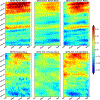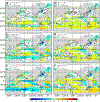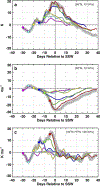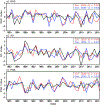GEOS-S2S Version 2: The GMAO High Resolution Coupled Model and Assimilation System for Seasonal Prediction
- PMID: 33959467
- PMCID: PMC8098100
- DOI: 10.1029/2019jd031767
GEOS-S2S Version 2: The GMAO High Resolution Coupled Model and Assimilation System for Seasonal Prediction
Abstract
The Global Modeling and Assimilation Office (GMAO) has recently released a new version of the Goddard Earth Observing System (GEOS) Sub-seasonal to Seasonal prediction (S2S) system, GEOS-S2S-2, that represents a substantial improvement in performance and infrastructure over the previous system. The system is described here in detail, and results are presented from forecasts, climate equillibrium simulations and data assimilation experiments. The climate or equillibrium state of the atmosphere and ocean showed a substantial reduction in bias relative to GEOS-S2S-1. The GEOS-S2S-2 coupled reanalysis also showed substantial improvements, attributed to the assimilation of along-track Absolute Dynamic Topography. The forecast skill on subseasonal scales showed a much-improved prediction of the Madden-Julian Oscillation in GEOS-S2S-2, and on a seasonal scale the tropical Pacific forecasts show substantial improvement in the east and comparable skill to GEOS-S2S-1 in the central Pacific. GEOS-S2S-2 anomaly correlations of both land surface temperature and precipitation were comparable to GEOS-S2S-1, and showed substantially reduced root mean square error of surface temperature. The remaining issues described here are being addressed in the development of GEOS-S2S Version 3, and with that system GMAO will continue its tradition of maintaining a state of the art seasonal prediction system for use in evaluating the impact on seasonal and decadal forecasts of assimilating newly available satellite observations, as well as to evaluate additional sources of predictability in the earth system through the expanded coupling of the earth system model and assimilation components.
Figures




















References
-
- Andrews DG, Holton JR, and Leovy CB (1987). Middle Atmosphere Dynamics. Academic Press, 489.
-
- AVISO MSLA (2013). http://www.aviso.oceanobs.com/en/data/products/sea-surface-height-produc....
-
- AVISO Altimetry (2013). https://www.aviso.altimetry.fr/en/data/products/auxiliary-products/mss.html.
Grants and funding
LinkOut - more resources
Full Text Sources
